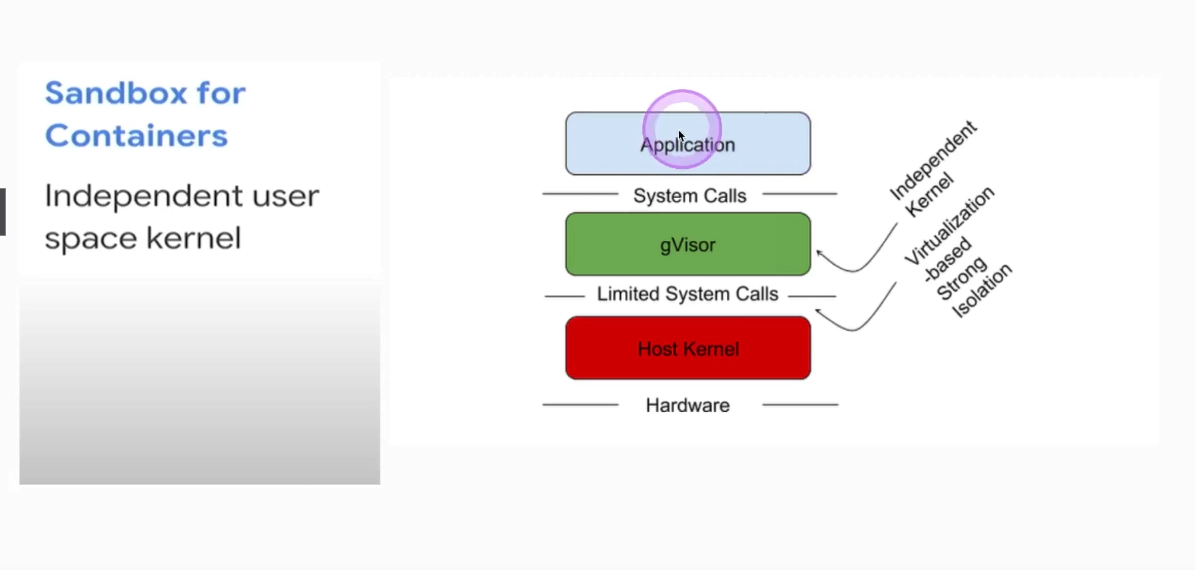I have been in DevOps related jobs for past 6 years dealing mainly with Kubernetes in AWS and on-premise as well. I spent quite a lot …
 :date_long | 3 min Read
:date_long | 3 min ReadCKS container runtimes





# go inside of a container and call
root@scw-k8s:~# k exec -it pod -- sh
/ # uname -r
5.4.0-96-generic
# step outside of a container and call
root@scw-k8s:~# strace uname -n
execve("/bin/uname", ["uname", "-n"], 0x7fff04c24c98 /* 24 vars */) = 0
brk(NULL) = 0x55bfd0cf3000
access("/etc/ld.so.nohwcap", F_OK) = -1 ENOENT (No such file or directory)
access("/etc/ld.so.preload", R_OK) = -1 ENOENT (No such file or directory)
openat(AT_FDCWD, "/etc/ld.so.cache", O_RDONLY|O_CLOEXEC) = 3
fstat(3, {st_mode=S_IFREG|0644, st_size=23538, ...}) = 0
mmap(NULL, 23538, PROT_READ, MAP_PRIVATE, 3, 0) = 0x7f6e56b83000
close(3) = 0
access("/etc/ld.so.nohwcap", F_OK) = -1 ENOENT (No such file or directory)
openat(AT_FDCWD, "/lib/x86_64-linux-gnu/libc.so.6", O_RDONLY|O_CLOEXEC) = 3
read(3, "\177ELF\2\1\1\3\0\0\0\0\0\0\0\0\3\0>\0\1\0\0\0\240\35\2\0\0\0\0\0"..., 832) = 832
fstat(3, {st_mode=S_IFREG|0755, st_size=2030928, ...}) = 0
mmap(NULL, 8192, PROT_READ|PROT_WRITE, MAP_PRIVATE|MAP_ANONYMOUS, -1, 0) = 0x7f6e56b81000
mmap(NULL, 4131552, PROT_READ|PROT_EXEC, MAP_PRIVATE|MAP_DENYWRITE, 3, 0) = 0x7f6e5656f000
mprotect(0x7f6e56756000, 2097152, PROT_NONE) = 0
mmap(0x7f6e56956000, 24576, PROT_READ|PROT_WRITE, MAP_PRIVATE|MAP_FIXED|MAP_DENYWRITE, 3, 0x1e7000) = 0x7f6e56956000
mmap(0x7f6e5695c000, 15072, PROT_READ|PROT_WRITE, MAP_PRIVATE|MAP_FIXED|MAP_ANONYMOUS, -1, 0) = 0x7f6e5695c000
close(3) = 0
arch_prctl(ARCH_SET_FS, 0x7f6e56b82540) = 0
mprotect(0x7f6e56956000, 16384, PROT_READ) = 0
mprotect(0x55bfced96000, 4096, PROT_READ) = 0
mprotect(0x7f6e56b89000, 4096, PROT_READ) = 0
...
Katacontainers
Katacontainers create a very lightweight VM with a separate kernel (quite different than a traditional containers) Strong separation layer! Using QEUM as default (needs virtualization, like neasted virtualisztion)

gVisor
- user-space kernel for containers (might be confusing)
- adds another layer of separation
- not hypervisor or VM based
- simulates kernel syscalls with limited functionality (in golang)
- runs in a user space separated from a linux kernel
- runtime is called
runsc


#!/usr/bin/env bash
# IF THIS FAILS then you can try to change the URL= further down from specific to the latest release
# https://gvisor.dev/docs/user_guide/install
# gvisor
sudo apt-get update && \
sudo apt-get install -y \
apt-transport-https \
ca-certificates \
curl \
gnupg-agent \
software-properties-common
# install from web
(
set -e
ARCH=$(uname -m)
URL=https://storage.googleapis.com/gvisor/releases/release/20210806/${ARCH}
# URL=https://storage.googleapis.com/gvisor/releases/release/latest/${ARCH} # TRY THIS URL INSTEAD IF THE SCRIPT DOESNT WORK FOR YOU
wget ${URL}/runsc ${URL}/runsc.sha512 \
${URL}/containerd-shim-runsc-v1 ${URL}/containerd-shim-runsc-v1.sha512
sha512sum -c runsc.sha512 \
-c containerd-shim-runsc-v1.sha512
rm -f *.sha512
chmod a+rx runsc containerd-shim-runsc-v1
sudo mv runsc containerd-shim-runsc-v1 /usr/local/bin
)
# containerd enable runsc
cat > /etc/containerd/config.toml <<EOF
disabled_plugins = []
imports = []
oom_score = 0
plugin_dir = ""
required_plugins = []
root = "/var/lib/containerd"
state = "/run/containerd"
version = 2
[plugins]
[plugins."io.containerd.grpc.v1.cri".containerd.runtimes.runsc]
runtime_type = "io.containerd.runsc.v1"
[plugins."io.containerd.grpc.v1.cri".containerd.runtimes]
[plugins."io.containerd.grpc.v1.cri".containerd.runtimes.runc]
base_runtime_spec = ""
container_annotations = []
pod_annotations = []
privileged_without_host_devices = false
runtime_engine = ""
runtime_root = ""
runtime_type = "io.containerd.runc.v2"
[plugins."io.containerd.grpc.v1.cri".containerd.runtimes.runc.options]
BinaryName = ""
CriuImagePath = ""
CriuPath = ""
CriuWorkPath = ""
IoGid = 0
IoUid = 0
NoNewKeyring = false
NoPivotRoot = false
Root = ""
ShimCgroup = ""
SystemdCgroup = true
EOF
systemctl restart containerd
Then you can create a runtimeClass and pod using that particular runtimeClass
apiVersion: node.k8s.io/v1
kind: RuntimeClass
metadata:
name: gvisor
handler: runsc
Create a pod itself
---
apiVersion: v1
kind: Pod
metadata:
labels:
run: gvisor
name: gvisor
spec:
runtimeClassName: gvisor
containers:
- image: nginx
name: gvisor
resources: {}
dnsPolicy: ClusterFirst
restartPolicy: Always